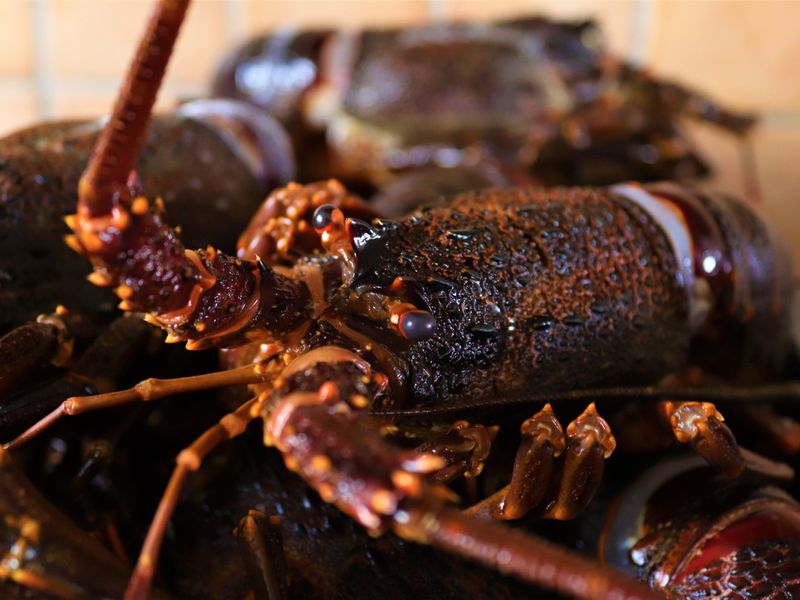South African Lobster

Species Details
Jasus lalandii
Palinuridae
Decapoda
Rocky reefs and kelp forests, Sandy beaches and estuaries, Cold, nutrient-rich waters, Intertidal zones
1 - 5 lbs.
8" - 12"
South African Rock Lobster: The Ocean’s Rock Star of the Cape!
Meet the South African rock lobster, a fierce and flavorful crustacean roaming the chilly rocky reefs and kelp forests off the Cape coast. Diving into its world means discovering the vibrant life and flavors of South Africa’s marine playground!
The South African rock lobster (Jasus lalandii), also known as the Cape rock lobster, is one of the most iconic marine crustaceans found along the southwestern coast of Africa. Known for its robust spiny exoskeleton and prized for its sweet, firm meat, this lobster plays a significant ecological and economic role in South African waters. In this article, we explore where the South African rock lobster lives, what it eats, its spawning habits, and the best places to find this fascinating species.
Where Does the South African Rock Lobster Live?
South African rock lobsters inhabit the cold to temperate marine waters along the coastlines of South Africa and Namibia, primarily from the Western Cape up to southern Angola. They prefer rocky reef environments and kelp forests, which provide ample shelter and abundant food sources. These lobsters are usually found at depths ranging from 5 to 200 meters (16 to 660 feet), with a preference for areas where complex rocky structures and dense kelp beds offer protection from predators and strong currents. The cool water temperatures in their habitat typically range between 10°C and 20°C (50°F to 68°F), making these waters ideal for their survival and growth.
What Do South African Rock Lobsters Eat?
South African rock lobsters are omnivorous scavengers and hunters. Their diet consists of a variety of marine organisms, which they actively forage for during the night when they are most active. They feed on mollusks such as mussels and limpets, crustaceans, sea urchins, and even dead or decaying organic matter. Their powerful claws and strong mandibles enable them to break open shells and hard exteriors to access the soft tissues inside. This diet not only sustains them but also helps regulate populations of other marine species, maintaining balance in their reef ecosystems.
Habitat and Behavior
The South African rock lobster’s habitat is characterized by rugged rocky reefs interspersed with kelp forests, which provide an ideal combination of shelter and food. The kelp beds serve as nurseries for juvenile lobsters, offering them protection during their vulnerable early stages of life. These lobsters are nocturnal creatures, spending the daytime hiding in crevices and under rocks to avoid predators such as fish, octopuses, and seals. At night, they venture out to forage along the seabed, often traveling significant distances in search of food. The structure of their habitat is critical for their survival, as it not only offers refuge but also supports the diverse marine life they feed on.
Spawning and Life Cycle
Spawning for the South African rock lobster typically occurs during the warmer months, from late spring through early summer. Females carry thousands of fertilized eggs beneath their tails for several weeks until the larvae hatch. These larvae enter a planktonic stage, drifting with ocean currents for several months before settling on the ocean floor as juvenile lobsters. During this time, the young lobsters grow and molt multiple times before reaching maturity. It generally takes about 4 to 5 years for South African rock lobsters to reach full adult size, making their reproductive cycle relatively long compared to some other crustaceans. Their migratory behavior, including seasonal movements to deeper waters for spawning, is an essential part of their life cycle.
Where to Find South African Rock Lobsters
If you want to spot or fish for South African rock lobsters, the best locations are the rocky coastal reefs and kelp forests off the Western Cape, particularly around Cape Town, False Bay, and along the Garden Route. The lobster fishing industry is well established in these areas, and local regulations govern sustainable harvesting to ensure populations remain healthy. Recreational divers and fishermen often look for these lobsters at night when they emerge to feed. However, strict fishing seasons, size limits, and protections on egg-bearing females are in place to conserve the species and support sustainable fisheries.
Conservation and Sustainable Fishing
The South African rock lobster is heavily targeted by commercial and recreational fisheries due to its high market value. To protect the species from overfishing, South Africa enforces various management measures, including closed seasons, size restrictions, and quotas. These regulations aim to allow the population to reproduce and maintain stable numbers. Conservation efforts also focus on preserving the kelp forest habitats, which are critical for the lobster’s lifecycle. Sustainable fishing practices and habitat protection are essential to ensure that future generations can continue to enjoy the ecological and economic benefits of this remarkable crustacean.
Conclusion
The South African rock lobster is a vital part of the marine ecosystem along southern Africa’s coast, thriving in rocky reefs and kelp forests. Its diet of mollusks and other marine life helps maintain ecological balance, while its complex life cycle and spawning behavior highlight the importance of protecting its habitat. Whether you are a seafood lover, diver, or marine enthusiast, understanding the South African rock lobster’s natural history and habitat is key to appreciating this remarkable species and supporting its sustainability.







